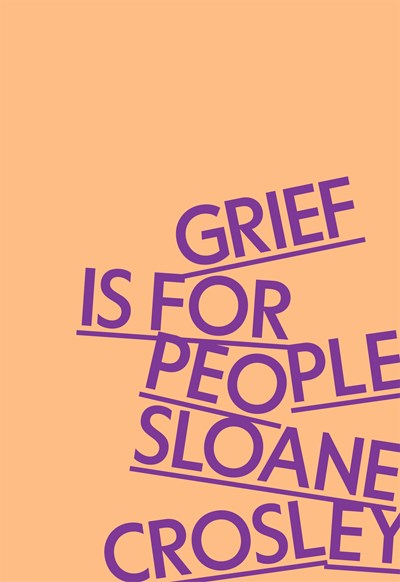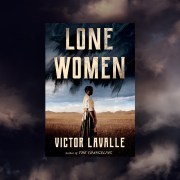[ad_1]
Content Warning: This review discusses suicide, which may be a difficult topic for some readers.
There is not one person on Earth that has been left untouched by grief. While it’s true that some of us experience it far more often than others, one’s grief is not something to be categorized or placed in comparison to someone else’s. Grief is something boundless, suffocating, and ineffable; in a lot of ways though, it also reminds us that we’re alive.
I’ve been a fan of Sloane Crosley for a while now. In fact, her 2022 hit, Cult Classic, currently sits staring at me from my bookshelf as I write this review. When I requested an advanced copy of Crosley’s new novel, Grief Is for People, though I had read the synopsis and prepped for a piece with more serious subject matter, I now realize I was not prepared for how heartbreaking this novel would be.
Grief Is for People centers around Crosley as she attempts to navigate life following two of the most harrowing experiences of her life: one being an unexpected burglary, and the second being the suicide of her dearest friend, Russell. In the summer of 2019, Crosley’s New York City apartment is broken into. The thief steals several pieces of family jewelry that have been passed down, setting in motion the beginning of a lengthy personal investigation in hopes of catching the culprit. Subsequently, Crosley grapples with the sense of invasion that the theft has left her with and begins to question the relationship between one’s possessions and self. Exactly one month after the burglary, the author’s closest friend commits suicide, and her world shifts in an instant.
Grief Is for People is split into 5 main chapters, with each section mirroring a classified stage of grief: denial, bargaining, anger, depression, and acceptance.
Crosley’s second chapter of the book covers the bargaining stage of grief through the lens of object permanence or “the understanding that something exists, even if it’s hidden.” The author holds a complicated relationship with the jewelry that was stolen from her apartment, for though it was passed down to her by her grandmother, Crosley makes it very clear that her grandmother was not a very kind figure in her life. Yet, Crosley recognizes that with the theft of her possessions—as “cursed” as she once believed them to be—comes a confounding sense of grief and loss.
Following the death of her best friend a month later, Crosley’s relationship with the missing jewelry transforms. She begins tirelessly searching for the thief and her jewelry as she grasps for any hope that what has been taken from her can be returned. Her jewelry, then, is intrinsically tied to Russell, for if she can succeed in finding what she has lost, she can find a piece of Russell once more. Yet, she soon realizes that though some things can find their way back, we cannot bargain with death.
In my margin notes, I have “This is one of the most beautiful things I’ve ever read” written next to a specific quote. Crosley writes:
“Everything you learn, you already knew, everything you know you have yet to learn. Perhaps in this one object, the past will have a bridge to the present, a bridge that will join wherever Russell is to where I am until one day, a long time from now, we can meet in the middle.”
As Crosley explains, it is in items that we inject feelings, hoping and praying that if we hold on tight enough, we can keep them with us forever. Where Crosley clutches her amber amulet for Russell, I hold my grandfather’s address book.
It is within this section of the novel that Crosley dives into the questions that linger around suicide, namely, how we perceive signs that were missed and how blame is placed after the fact. As Crowley explains, while there is no hierarchy of tragedies, suicide is unlike any other type of death. It is solitary and isolating, violent and misunderstood. It is an “unbalanced death” with “a more permeable loss,” often one in which the victim is mourned and scrutinized within the same breath. Despite the constant discussions around the “how” and the “why,” Crosley’s grief is not linear, nor is it always explainable.
As anger can be the most complex stage of grief, Crosley’s next chapter is split into 3 subsections. As the chapter continues, the author’s anger simmers and spirals until it becomes unbearable to be held in silence. Crosley reflects on all that surrounded Russell before his death—the people, the job, and the world that took from him daily. She recognizes both silent and loud pain, and how tragedies—as devastating as it is—may never have true resolve. Amid inexplicable sorrows such as these, it is completely valid to be upset. Yet, the truly infuriating part of it all is that there’s no one root cause of anger in relation to grief; rather, your anger is directed at everyone and everything for what you’ve lost. It is a heartbroken defense mechanism to keep you from being consumed whole by despair.
As Crosley finds, while grief is consuming at times, it’s also something we must accept. We will never be able to move on completely from the losses we’ve experienced, nor should we. However, to honor the people that we have loved and lost, we must “learn to be on the side of the living.” Only in doing so, can we begin to heal.
Crosley expertly weaves her humor into the narrative, never shying away from finding the lighthearted in the macabre. Her storytelling abilities are mesmerizing as she balances themes of angst, love, and heartbreak, all whilst maintaining an introspective, intimate, and frank voice. While it’s true that Grief Is for People by Sloane Crosley is a novel about grief, it is also a novel about ultimate perseverance.

FICTION
Grief Is for People
By Sloane Crosley
MCD
Published February 27, 2024
[ad_2]
Source link

